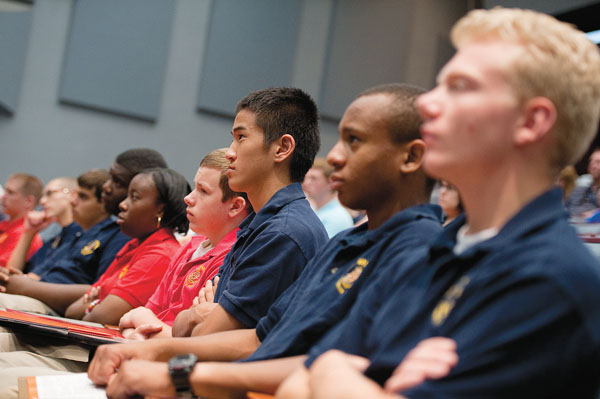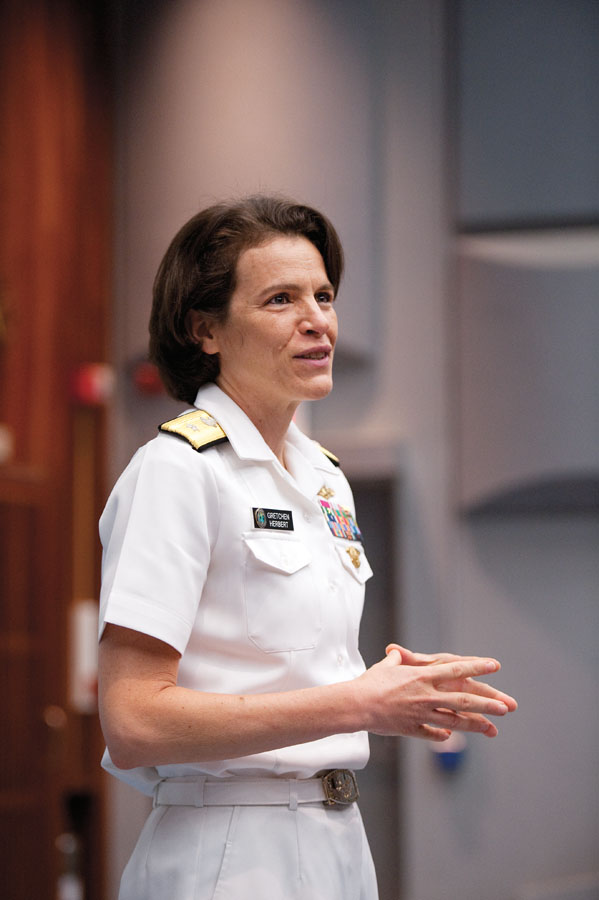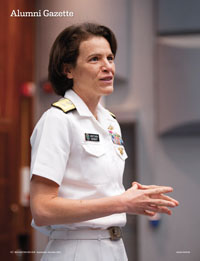Alumni Gazette
 ATTENTION: Rochester area high school students and their parents (above) listen to Rear Admiral Gretchen Herbert ’84 (opposite) in Hoyt Hall in July as part of Navy Week, an outreach program that showcases naval operations and opportunities. (Photo: Adam Fenster)
ATTENTION: Rochester area high school students and their parents (above) listen to Rear Admiral Gretchen Herbert ’84 (opposite) in Hoyt Hall in July as part of Navy Week, an outreach program that showcases naval operations and opportunities. (Photo: Adam Fenster) (Photo: Adam Fenster)
(Photo: Adam Fenster)Rear Admiral Gretchen Specht Herbert ’84 doesn’t often get the chance to visit her hometown of Irondequoit, just north of Rochester, much less to stroll the River Campus, where, she says, 30 years ago her daily life as a student, athlete on the women’s basketball and soccer teams, and NROTC scholar “really molded who I am.”
But the newly installed commander of Navy Cyber Forces got that rare chance in July. During her day-long visit to the campus, she delivered a talk to high school students about her 25-year career in the Navy, which began with her NROTC scholarship at Rochester, and, along with President Joel Seligman, toured the University’s newly installed electronic classroom—a room in Lattimore Hall outfitted with 12 computers with dual monitors that will help Naval ROTC students develop navigation skills in a full range of environmental conditions.
The sea can seem like a distant place, even to those who live near the coasts. But as Herbert told her audience of prospective students and parents, not only is almost three-quarters of the globe covered by water, but 80 percent of the world’s population lives within 100 miles of the coast. About “90 percent of all international commerce, from your sneakers, to your TV sets, to your laptops, to your milk and butter, travels via the sea,” she said. “And to make sure those sea lines of commerce are open, we’re out there patrolling,” she added, referring to the Navy’s involvement in an international coalition to combat piracy off the coast of Somalia as a recent example.
There are other dimensions to the Navy’s mission, of course, and in her talk and in a follow-up interview, she reflected on the implications of her new role, which she began in June, as commander of Navy Cyber Forces.
Herbert began her naval career, just following graduation, engaged in antisubmarine warfare, tracking Soviet submarines off the coast of Bermuda. That was in 1984, when, she says, “there were two great powers, you knew where your enemy was, you knew what your mission was.”
But since then, developments in technology and geopolitics have made national security a much broader and more complex enterprise. For example, the Navy has traditionally had a command for the surface navy, a command for aviation, and a command for submarines. The establishment of a command for manning, training, and equipping the Navy’s initiatives in cyber forces, she says, is “a recognition by the Navy that cyber and cyberspace has risen to a level of increased importance and is actually very much like any other war fighting area.” And as commander of Navy Cyber Forces, her job “is to ensure that the fleet has the tools and the training and the personnel to be able to operate in and through cyberspace.”
To give a sense of the threats emerging in cyberspace, Herbert says that “across the Department of Defense networks, there are about 6 million probes a day.” Probes, she clarifies, “are something very different from attacks. They’re a ‘testing of the waters’ kind of thing. But some of those probes go farther and are actually aimed at particular information.” That information might include intellectual property, plans for an operation, or information about “the capabilities and limitations of our armed forces.”
Herbert studied geology at Rochester, and as she told the audience of prospective students and parents, “I can tell you I don’t do anything with rocks.” What college teaches, she said, is “the ability to look at things critically, and to make interpretations”—as well as “how to multitask and prioritize.”
She’s received schooling and on-the-job training from the Navy for each of the many positions she’s held. As she’s worked her way up the Navy hierarchy—her current rank is rear admiral—she’s embarked on a new job every two to three years. Often, she says, it’s “something totally different” from her previous roles.
Her favorite mission? “My first sea duty job,” she says. The job was combat systems officer aboard the USS George Washington, a nuclear-powered aircraft carrier that, with 5,000 servicemen and women on board, could seem like a small, floating city. “If I could go back to sea tomorrow, you could bet I’d be doing it. And if they told me that I’d have to give up a couple of stripes to go back,” she adds, “I’d do it in a heartbeat.”

